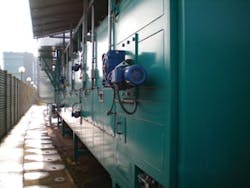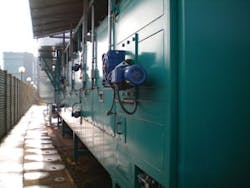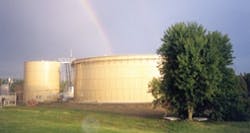Igloo-shaped device eats sewage
SALT LAKE CITY, Jan. 10, 2011 -- Inexpensive igloo-shaped, pollution-eating devices nicknamed "Poo-Gloos" can clean up sewage just as effectively as multimillion-dollar treatment facilities for towns outgrowing their waste-treatment lagoons, according to a new study.
"The results of this study show that it is possible to save communities with existing lagoon systems hundreds of thousands, if not millions of dollars, by retrofitting their existing wastewater treatment facilities with Poo-Gloos," says Fred Jaeger, chief executive officer of Wastewater Compliance Systems Inc., which sells the Poo-Gloo under the name Bio-Dome.
Kraig Johnson, chief technology officer for Wastewater Compliance Systems, will present the study Jan. 13 in Miami during the Water Environment Federation's Impaired Water Symposium. It also will be published in the symposium program.
Wastewater treatment in small, rural communities is an important and challenging engineering task. Proper treatment includes disinfection and the removal of unwanted pollutants. Most rural communities rely on wastewater lagoons as their primary method of treatment because they are simple and inexpensive to operate. Lagoons are large ponds in which sewage is held for a month to a year so that solids settle and sunlight, bacteria, wind and other natural processes clean the water, sometimes with the help of aeration.
But as communities grow and-or pollution discharge requirements become more stringent, typical wastewater lagoons no longer can provide adequate treatment. Until now, the only alternative for these communities was to replace lagoons with mechanical treatment plants, which are expensive to build and operate. Mechanical plants treat water in 30 days or less, using moving parts to mix and aerate the sewage, speeding the cleanup. They require electricity, manpower and sometimes chemicals.
Johnson and his research team developed the Poo-Gloo when he worked as a research assistant professor of civil and environmental engineering at the University of Utah. The Poo-Gloo was designed to address the problem faced by communities outgrowing their sewage lagoons. The device provides a large surface area on which bacteria can grow, providing the microbes with air and a dark environment so they consume wastewater pollutants continuously with minimal competition from algae.
Lynn Forsberg, public works director for Elko County, Nev., recently started using Poo-Gloos in a county sewage treatment lagoon system in Jackpot, Nev., after a successful pilot test. "Our alternative was to go with a full-blown [mechanical] treatment plant that would cost about four times as much and be much more labor intensive," he says.
How Poo-Gloos Work
Poo-Gloos use a thriving bacterial biofilm to consume pollutants. Two dozen or more igloo-shaped Poo-Gloos are installed on the bottom of the lagoon, fully submerged and arrayed in rows. Each Poo-Gloo consists of a set of four progressively smaller, plastic domes nested within each other like Russian nesting dolls and filled with plastic packing to provide a large surface area for bacterial growth.
Rings of bubble-release tubes sit at the base of every Poo-Gloo and bubble air up through the cavities between domes. The air exits a hole in the top of each dome. As air moves through the dome, it draws water from the bottom of the lagoon up through the dome and out the top.
The Study: How Much Poo Can a Poo-Gloo Remove?
Johnson spent time in the wastewater industry before obtaining his master's and doctoral degrees in civil and environmental engineering. In 2002, he set about developing a product that could be used to retrofit wastewater lagoons easily and inexpensively. After seven years, with the help of fellow professors, graduate students and a lot of laboratory tests, Johnson was ready for his first field test.
Johnson built a pilot unit using a large construction dumpster welded shut so it was water-tight. The container held seven Poo-Gloos. Johnson enlisted the help of Salt Lake's Central Valley Water Reclamation Facility to test it. The researchers ran multiple tests using untreated wastewater from the plant to determine the extent to which commonly regulated pollutants could be removed from the wastewater before discharge back to the treatment facility.
The study aimed to determine optimal operating conditions for Poo-Gloos and evaluate their performance at different water temperatures, levels of aeration, and sewage volumes and concentrations. The study found the devices consistently achieved high levels of treatment that were affected only slightly by changing water temperatures and aeration levels:
- Biological oxygen demand -- a measure of organic waste in water -- was reduced consistently by 85 percent using Poo-Gloos, and by as much as 92 percent.
- Total suspended solids fell consistently by 85 percent, and by as much as 95 percent.
- Ammonia levels dropped more than 98 percent with Poo-Gloo treatment in warmer water and, more important, by as much as 93 percent when temperatures dropped below 50 degrees Fahrenheit -- conditions that normally slow bacterial breakdown of sewage.
- Total nitrogen levels fell 68 percent in warmer water and 55 percent in cooler water.
"The removal rates we saw during the pilot test are comparable to removal rates from a rotating biological contactor, which is a commonly used device in mechanical treatment facilities," Johnson says. "We couldn't be happier with the performance of the Poo-Gloos."
Johnson conducted the study with Hua Xu, a postdoctoral fellow in civil and environmental engineering at the University of Utah, and Youngik Choi, a professor of environmental engineering at Dong-A University in South Korea.
There may be uses for the Poo-Gloos beyond municipal wastewater treatment.
"The bugs will adapt to consume whatever is available," says Johnson, "In addition to the pollutants discussed in our paper, we've also seen great results in the consumption of other significant pollutants that I can't discuss now because we're in the process of filing patents. Poo-Gloos -- or Bio-Domes as we call them -- have a lot of potential, and we've only just scratched the surface."
Johnson and his team originally nicknamed the devices Poo-Gloos because they are shaped like igloos. But as possible uses began to expand to industries beyond municipal sewage treatment, Wastewater Compliance Systems decided to sell them as Bio-Domes.
From Nevada to Alabama and Wisconsin, Poo-Gloos to the Rescue
"Every day I speak with community officials who need to upgrade their treatment facilities," says Taylor Reynolds, director of sales for Wastewater Compliance Systems. "They come to us because they receive an engineering report recommending a $4 million to $10 million mechanical plant project that is impossible for them to pay for with their existing tax base. Not only can our Poo-Gloos or Bio-Domes help communities comply with pollution limits, but most of the projects I quote cost between $150,000 and $500,000, and the operating expenses are a fraction those at a mechanical plant."
Each Poo-Gloo requires little maintenance and the same amount of electricity as a 75-watt bulb, putting operating costs for Poo-Gloo systems at hundreds of dollars per month rather than thousands, which is typical of mechanical treatment plants. And some communities may operate Poo-Gloos "off-the-grid" by powering them with solar or wind energy systems.
The results of the new study prompted a number of communities to abandon more expensive alternatives in favor of installing Poo-Gloos. These early adopters can be found in the Nevada town of Jackpot in Elko County, Glacier National Park in Montana, and Plain City and Wellsville in Utah. Wastewater Compliance Systems also has deployed mobile pilot Poo-Gloos in Louisiana, Alabama and Wisconsin so potential customers, engineering firms and regulators can see first-hand how well they work before they commit tax dollars to the new technology.
"We know that small communities have limited budgets," Reynolds says. "That's why we developed our mobile pilot units. Even when our technology has the potential to save hundreds of thousands of dollars on an upgrade project, we like to provide our customers with peace of mind in knowing that our products will solve their problems for years to come. "
For more information on the Poo-Gloos and Wastewater Compliance Systems, please visit: www.wastewater-compliance-systems.com
###


